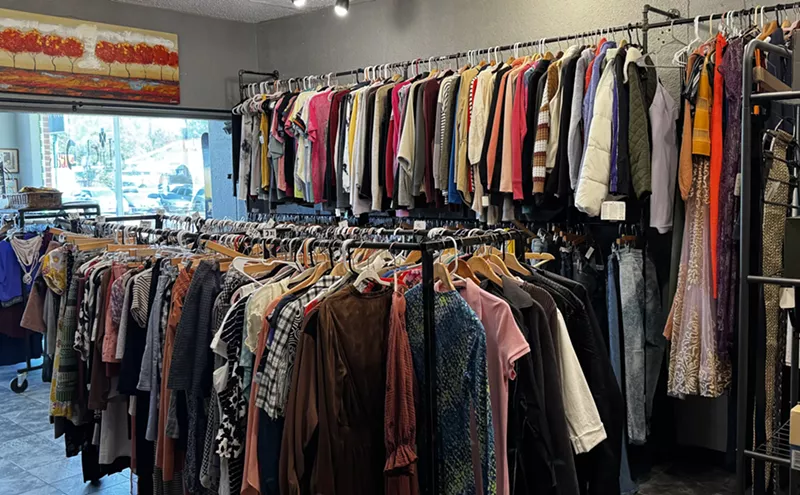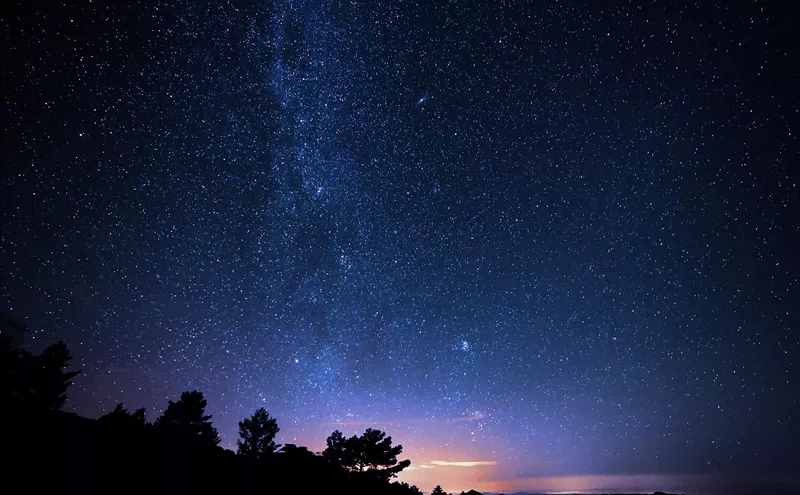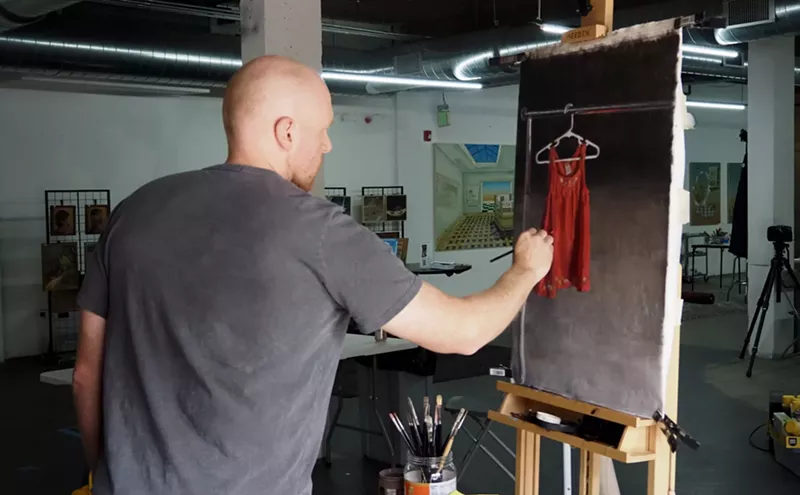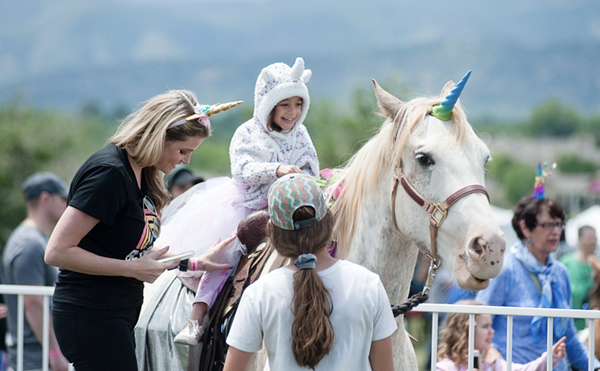Metropolitan State College of Denver is not just one of the city's major institutions of higher learning; it's also the state's largest art school. The most obvious evidence of this focus is the college's Center for Visual Art in LoDo. This multi-gallery venue has distinguished itself as one of the region's top spots for the exhibition of contemporary and modern art — and while other colleges maintain exhibition spaces on-campus, only Metro has its own little museum located off-campus and out in the middle of things.
A more subtle indication of the importance Metro places on art is the school's enormous multimedia art department, which has nearly fifty teachers instructing in a wide range of fine-art mediums. Although the CVA doesn't specifically focus on the activities at Metro, it does sometimes shine its spotlight on the work of those associated with the college.
That's the story with Collective Nouns: MSCD Art Faculty Biennial, featuring work by most of the artists who teach there. As you might expect, the show is wide-ranging and, for that reason, unwieldy, but CVA director Jennifer Garner and assistant director Cecily Cullen have — as usual — brought all the disparate pieces together.
I don't always go to faculty exhibits, but I'm a real "be here now" kind of person, and I couldn't resist the temptation to see works by dozens of artists currently active in the area. Adding to this personal appeal is the fact that, with a few exceptions, I had never heard of most of them, let alone seen their work. That's because many of these artists rarely participate in local exhibitions. It's odd to me that people who teach art are often loath to show it, but apparently that's the way it is — and not just at Metro, but in general.
With a show this large and diverse — and of such varying quality — I needed to amble through it a couple of times before I could absorb an accurate impression of the department. One thing that really stands out is the importance accorded to photography and other photo-related mediums. Another is the relatively limited attention placed on sculpture, and though there are several entries on view in various three-dimensional forms, these are mostly limited to installations and crafts.
Because of this inequality among the mediums, it was impossible for Garner and Cullen to separate pieces into discrete sections devoted to each, since some categories would be very large while others would be embarrassingly small. As a result, the show is installed more or less instinctually, with no real internal organization, which creates something of a problem when discussing it. Typically I look at exhibits as a visitor would experience them, going from gallery to gallery, but in this case, I'll need to talk about pieces by medium, regardless of where they are displayed.
Given the high quality of the photo-based selections, much of them straightforward photography, it makes sense to start there. In Kenn Bisio's "Man With the Taped Eyes," he has captured a man whose eyes are bandaged and who carries a cane. The composition is marvelous, with the man emerging from the shadows on the right and a pair of posters off to the left creating an asymmetrical balance. Apparently there's a narrative component as well, but it's hard to say what Bisio had in mind.
Less traditional, though equally enigmatic, is "Untitled," from Rebecca Dolan's "Plane" series. It's intriguing, and I'd love to see it in the context of its related pieces. The inkjet-on-aluminum photo depicts the interior of an airplane window, and I can only surmise that the others in the series take up the same topic. It's murky and iconic, and as simple and modest as it is, it works.
A pair of untitled photos by Natascha Seideneck are stylistically related to Dolan's piece and similar from a technical standpoint, as they are also done with inkjet on aluminum. The bluish disks resemble portholes, especially since one of them has a blurry view of the sea in the middle.
Photos with cultural subject matter are also included. Merlin Madrid's untitled image of an art-of-identity piece, presumably autobiographical, includes a large image of a young Latina girl combined with small images of older women across the bottom. Edie Winograde is represented by "The Decisive Battle of San Jacinto," an archival inkjet print depicting a historic re-creation of an event; in it, men wearing period costumes and holding long guns are running across a field. There's no question this is a present-day scene, because there's an assembled crowd of onlookers in the background and, further back, power lines. Winograde's photos are both funny and elegant.
Much of Collective Nouns is given over to photography, but even more artists use photographic methods, including video. I'm thinking here of "Hitchcock Heroine," by Kelly Monico with Scott Bagus, in which footage from Alfred Hitchcock films has been combined with a haunting minimalist soundtrack synched to the changes in the visuals. Then there's Cinthea Fiss's "Mutant Fan 2, 2009 Pioneers of Punk San Francisco," an interesting and poignant cluster of photos put together with a video and a catchy soundtrack that juxtaposes concert scenes and unrelated found footage.
The socio-cultural theme is also seen in Peter Regenold Bergman's installation of photos, text and found objects called "West Denver Urban Preserve and Trail," in which the artist altered and documented a gritty landscape. It's the kind of thing that's been done before — many times — but somehow Bergman makes it fresh and eye-catching. Although the same kind of conceptualism informs Casey McGuire's installation, "Trajectory," which includes a dog sled, bicycle wheels and four video monitors, its message, whatever it may be, is much less straightforward. But I liked this piece in spite of myself.
Also melding three-dimensional elements with photos is Sandy Lane's charming wall installation, "They Lived in My House," a box covered in photocopies of old snapshots and with windows on one end that reveal a dollhouse interior.
There are a number of other small installations that don't include photography, such as the whimsical "Spheres," by Brian Evans, made up of mechanized orange plastic orbs that knock around an aluminum floor (I wish it were bigger); the pair of engraved hedge clippers by Lisa Abendroth that promotes lawn maintenance as part of her "Domesticated Landscapes" series and a trio of Bonnie Ferrill Roman's hanging "Accumulation" pieces made of paper, the curvilinear shapes of which were determined by bent-wire armatures.
In addition to all of these photos and installations, there's a healthy dose of old-fashioned drawings and paintings. One of the most striking pieces in the entire show is a drawing, titled "Apparition," by Anna Kaye, an expertly rendered scene of trees in the mist that I first thought was a photo, it's so meticulously done. Also perfectly made, though in very different ways, are the all-over abstraction "A View of Up From Below," by Mark Brasuell, and the neo-abstract-expressionist "Magellan," by Amy Metier. Unlike most of the artists/teachers in this show, Brasuell and Metier regularly exhibit their work around town and are thus better known than most of the others.
Considering how large this show is, it's impossible to talk about everything that caught my eye, like the wonderful Carlos Frésquez print "A Fairy Tale," which conflates Mexican immigration with The Jetsons. But it goes without saying that I heartily recommend Collective Nouns.











